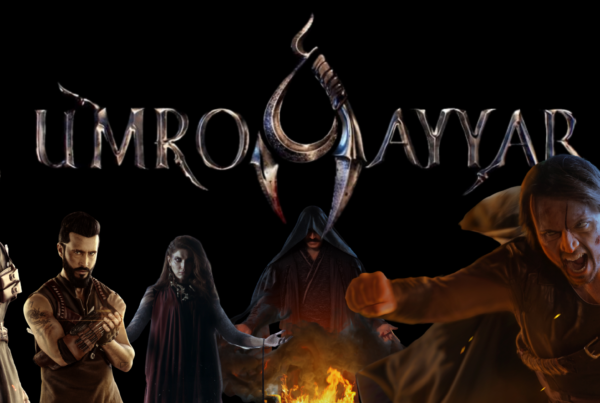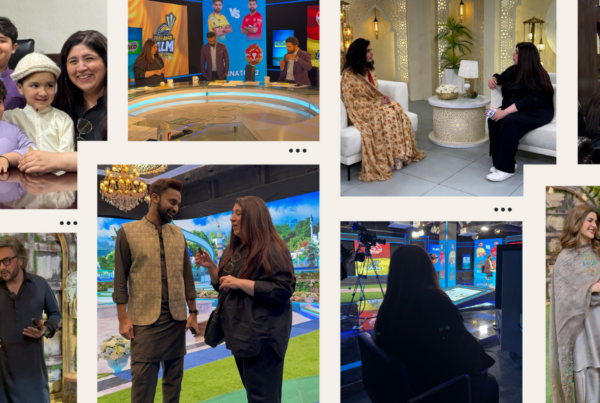Ali Xeeshan is as old as fashion week. Seven years into his unforgettable 2010 fashion week debut, he is one of Pakistan’s most prominent designers today. A creative whizz, he’s either loved or hated but it’s impossible to ignore this fashion creature that has emerged with the Ali Xeeshan Theatre Studio. Ali’s collections are as vibrant as his personality; one remembers the parrot rings, the symbolic monkeys, the Mickey Mouse dance and many more runway moments alongside his personal, ever-evolving looks that have been just as intriguing. It’s impossible to forget an image of Ali wearing a rooster on his hat, having a Dali moment for a themed show. The rooster was perched over an egg and people were so amused by the image that no one bothered to notice the biological impossibility of the implication.
The Mickey and Minnie Mouse finale was another hilarious show of creativity. Designers had started bringing in top stars to draw attention to their collections (it had become monotonous and humdrum at this point) and true to character, Ali Xeeshan did something completely different. He brought out life size Mickey and Minnie Mouse characters, dancing to a popular Punjabi track on the runway while wearing his collection, replete with ornamental bridal jewellery. It’s only when the jewellery partner asked for a picture of the finale did a problem arise; the sponsor may not have appreciated their priceless pieces dangling from the ears of cartoons!

Ali’s debut show in 2010.
He may get a lot of attention because of his theatrics but Ali Xeeshan’s talent and work discipline is never compromised in the process, which is why he’s gone from nowhere to everywhere in a short span of seven years. While designers alternate between showing or not showing, Ali Xeeshan – a PIFD graduate – is today the most regular participant at fashion week.
“Fashion weeks help me keep the creative process alive,†he said as we met at his studio in Karachi, where Ali flies down to take appointments once a month. “They give me the discipline to design and innovate otherwise we’d all get pulled into this big hole of making clothes and selling clothes. Collections I design at fashion week give me discipline. Clients know the collections and they come to me, knowing exactly what they want.â€
Closely observing Ali Xeeshan’s growth in the fashion industry has been an entertaining exercise but one has often wondered where this quirky individual was coming from. Was his a carefully orchestrated persona, manufactured for public consumption, or was there a genuine source of identity in his kitsch?
“I’m a hardcore Punjabi,†Ali laughed when I asked him where his craziness was coming from. He explained how he lived in a joint family in Lahore’s Samanabad, and how there were always so many relatives and cousins around him that he had learnt how to find a method to the madness while growing up. “My mother is the coolest person around me and she has been the biggest influence on my design ethos,†he continued. “Growing up I saw and admired her as a boisterous, eccentric dresser. She’d have to wear the burqa but she loved flashing a little cleavage whenever she could. My mother does not even consider beige a colour,†he laughed.
“I’m good with compositions because I grew up in a joint family system and I learnt how to balance emotions, chaos and expression.â€

This collection Khamoshi referred to the taboo of child marriages in Pakistan.
Was his family supportive of his lifestyle?
“My family loves me; they are very supportive,†he responded. “My mother actually encouraged me to wear the kukkar (rooster) on my head and if I ever dress normal my parents worry that something is wrong.â€
Dressing abnormal is now part of Ali’s identity; an element of theatrics is part of his shows. I observe him as he speaks and as he’s meeting clients he is dressed rather conservatively today; he’s in a black suit worn over a white tee shirt and his only kitsch is in his oversized glasses, watch and shoes that flash a bright shade of gold. Individuality is what makes a designer unique and any designer’s label is considered strong only if it can balance originality and innovation with an ability to sell that vision. Ali had managed to ace all dynamics at a time when even veteran and established brands were struggling.
Read: Ali Xeeshan to direct Shaan-e-Pakistan’s third edition
What was the core of his success?
“You need to have your own vocabulary as a brand,†he replied clearly. “A successful brand today is a combination of a unique aesthetic but also strong marketing and strategy. A fashion brand needs to have a voice and as a brand I have a voice and I’m singing my own song. You can only succeed in this very competitive fashion world if you’re authentic and true to yourself. It’s only when you know that your strength is not borrowed and that gives you confidence to grow.â€
Ali has also been a strong advocate of promoting our culture in fashion. His collections are a unique blend of colours, handicraft, silhouettes and ideas. It’s amazing how they all blend together in cohesion.
“We do need to project our culture better,†he agreed. “We need to explore our roots more because that’s where the fascination for Pakistani fashion lies. My clothes are spicy; they’re like the six seasons we have.â€
Ali Xeeshan Theatre Studio was a name that interested everyone these days but who were the names that he was interested in dressing?
“Meesha Shafi, Amna Baber and Kiran Malik…these women have amazing body language and person style. I always love designing for them.†And then in true characteristic honesty he concluded, “I cannot be bothered with TV actresses who have no personality!â€
This article was originally published in Instep on Saturday, 2nd September 2017.Â





